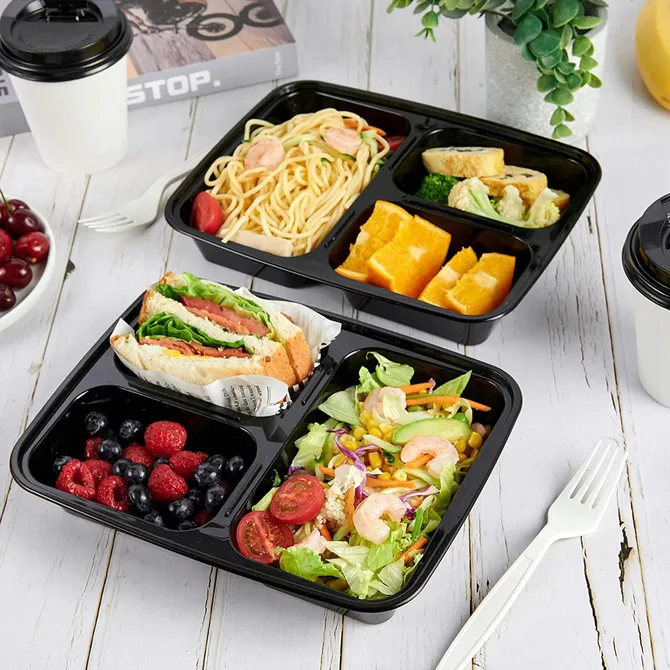Introduction to Meal Prep Containers
Meal prep containers have revolutionized the way people approach healthy eating and time management in the kitchen. Whether you’re a fitness enthusiast, a busy professional, or someone looking to save money on takeout, these containers help you store pre-portioned meals efficiently.
The right meal prep containers keep your food fresh, prevent spills, and make reheating a breeze. With various materials, sizes, and designs available, choosing the best one can be overwhelming. This guide will break down everything you need to know—from plastic to glass options, portion control benefits, and even eco-friendly choices.
Why Meal Prep Containers Are a Game-Changer
Meal prep containers are more than just storage solutions—they are essential tools for maintaining a healthy and organized lifestyle. By dedicating a few hours each week to meal prepping, you can save time, reduce food waste, and stick to your dietary goals effortlessly.
One of the biggest advantages is portion control. Instead of guessing serving sizes, meal prep containers allow you to measure exact portions, helping with weight management and balanced nutrition. Additionally, they keep your fridge neat, eliminating the chaos of mismatched bowls and plastic wraps.
Another benefit is cost savings. Preparing meals in advance reduces the temptation to order fast food, ultimately cutting down on unnecessary expenses. Whether you’re meal prepping for the week or just storing leftovers, these containers ensure your food stays fresh and ready to eat.

Types of Meal Prep Containers: Which One is Right for You?
Plastic Meal Prep Containers
Plastic containers are lightweight, affordable, and widely available. They come in various shapes, including compartmentalized designs that keep different food items separate. Many are microwave-safe and dishwasher-friendly, making reheating and cleaning hassle-free.
However, not all plastic containers are created equal. Look for BPA-free options to avoid harmful chemicals. While plastic is durable, it may stain over time or retain odors from strong-smelling foods like curry or garlic.
Glass Meal Prep Containers
Glass containers are a premium choice for meal prepping. They are non-toxic, don’t absorb odors, and are safe for both microwaving and oven use. Glass also maintains food freshness better than plastic, making it ideal for long-term storage.
The downside? Glass is heavier and more fragile, which may not be ideal for travel. However, brands like Pyrex and Glass lock offer tempered glass options with secure lids to prevent leaks.
Stainless Steel Meal Prep Containers
For those looking for an eco-friendly and durable option, stainless steel containers are a great pick. They are lightweight, rust-resistant, and free from harmful chemicals. These containers are perfect for cold meals like salads but are not microwave-safe.
Stainless steel is also easy to clean and doesn’t retain stains or odors. Brands like ECO lunchbox and U-Kon serve offer sleek, stackable designs for easy storage.
Silicone Meal Prep Containers
Silicone containers are flexible, collapsible, and space-saving. They are microwave-safe, freezer-friendly, and easy to clean. These are perfect for those with limited storage space or who prefer lightweight options.
However, silicone containers may not be as sturdy as glass or stainless steel. They are best suited for snacks or smaller portions rather than full meals.
Key Features to Look for in Meal Prep Containers
Leak-Proof Lids
No one wants a lunch bag soaked in soup or sauce. Look for containers with secure, snap-on, or locking lids to prevent spills. Silicone seals provide extra protection against leaks.
Microwave and Freezer Safety
Ensure your containers can handle both reheating and freezing. Glass and BPA-free plastic are usually safe, but always check the manufacturer’s guidelines.
Compartmentalized Designs
Containers with dividers help keep foods separate, preventing sogginess and flavor mixing. This is especially useful for meal preppers who like variety in their meals.
Stack ability and Space Efficiency
Containers that nest or stack neatly save fridge and cabinet space. Uniform sizes make organizing easier, especially if you prep multiple meals at once.
Top 5 Meal Prep Containers in 2024
| Brand | Material | Key Features | Best For |
|---|---|---|---|
| Glasslock | Glass | Airtight, leak-proof, oven-safe | Family meal prep |
| Meal Prep Haven | BPA-free Plastic | Compartmentalized, microwave-safe | Portion control |
| Pyrex | Tempered Glass | Durable, freezer-safe, stackable | Leftovers & meal prep |
| ECOlunchbox | Stainless Steel | Eco-friendly, lightweight, odor-free | Eco-conscious users |
| Prep Naturals | Plastic & Glass | Bento-style, leak-proof, portioned | Office lunches |
How to Properly Clean and Maintain Meal Prep Containers
Dishwasher vs. Hand Washing
Most plastic and glass containers are dishwasher-safe, but hand washing extends their lifespan. Avoid harsh scrubbers that can scratch surfaces.
Removing Stains and Odors
For plastic containers, a mix of baking soda and vinegar can remove stubborn stains. Glass and stainless steel are naturally odor-resistant but should be cleaned promptly.
Storage Tips
Store containers with lids off to prevent moisture buildup. Keep them in a dry, cool place to avoid warping (especially plastic).
Best Glass Meal Prep Containers (Healthline)
Eco-Friendly Food Storage (EPA)
FAQs About Meal Prep Containers
1. Are plastic meal prep containers safe?
Yes, if they are BPA-free. Always check labels to ensure they are microwave-safe and free from harmful chemicals.
2. Can I freeze food in glass containers?
Yes, but ensure the glass is tempered and labeled as freezer-safe to prevent cracking.
3. How often should I replace meal prep containers?
Replace plastic containers if they become warped or stained. Glass and stainless steel last longer with proper care.
4. What’s the best size for meal prep containers?
It depends on your portions. 20-32 oz containers work for full meals, while smaller ones (8-12 oz) are great for snacks.
Conclusion
Meal prep containers are a must-have for anyone serious about healthy eating and time management. Whether you prefer plastic, glass, or stainless steel, the right containers can simplify your routine, reduce waste, and keep your meals fresh.
Investing in high-quality meal prep containers pays off in convenience and long-term savings. Ready to start meal prepping like a pro? Choose the best containers that fit your lifestyle and enjoy stress-free, organized meals every day.




